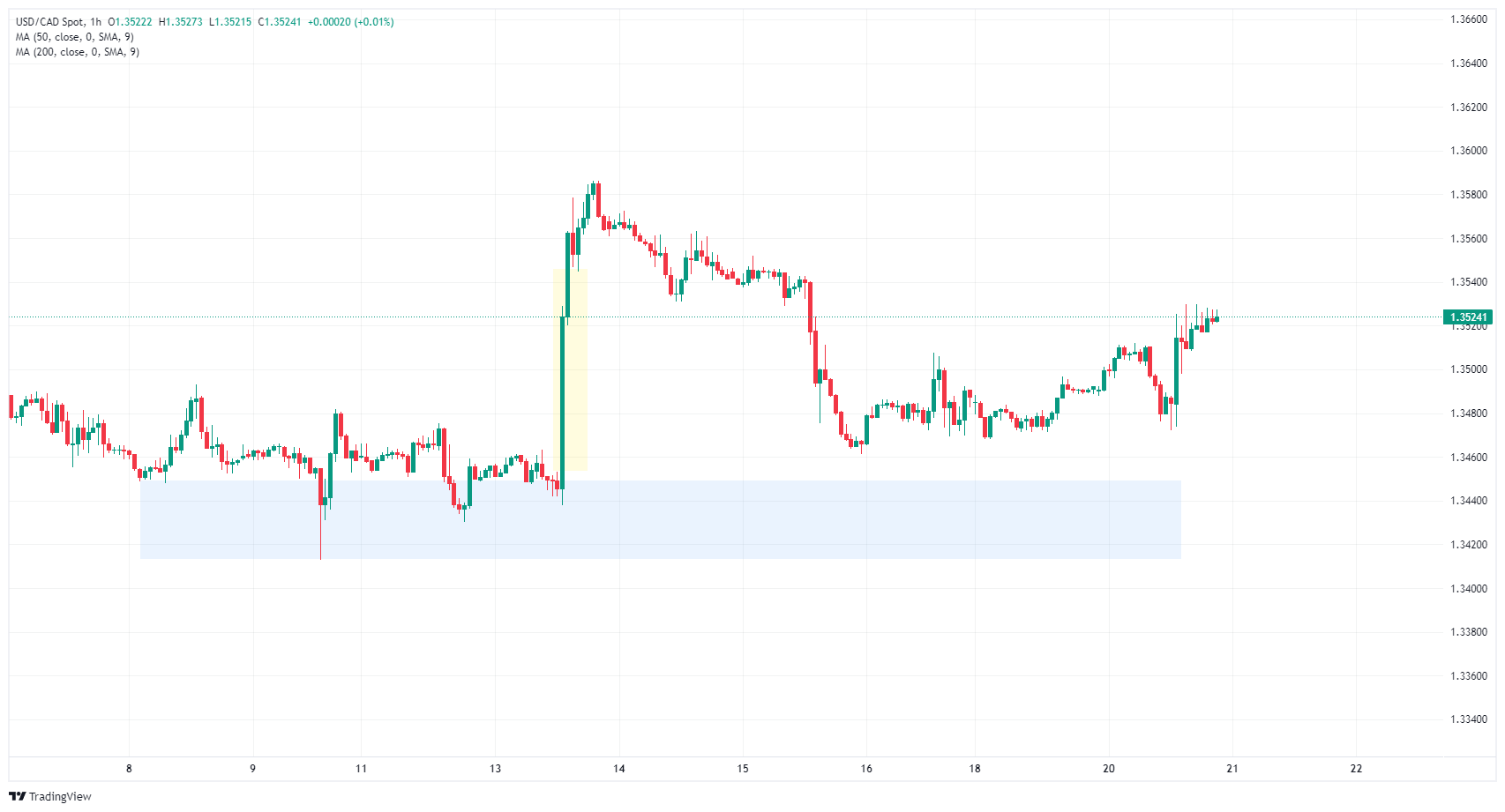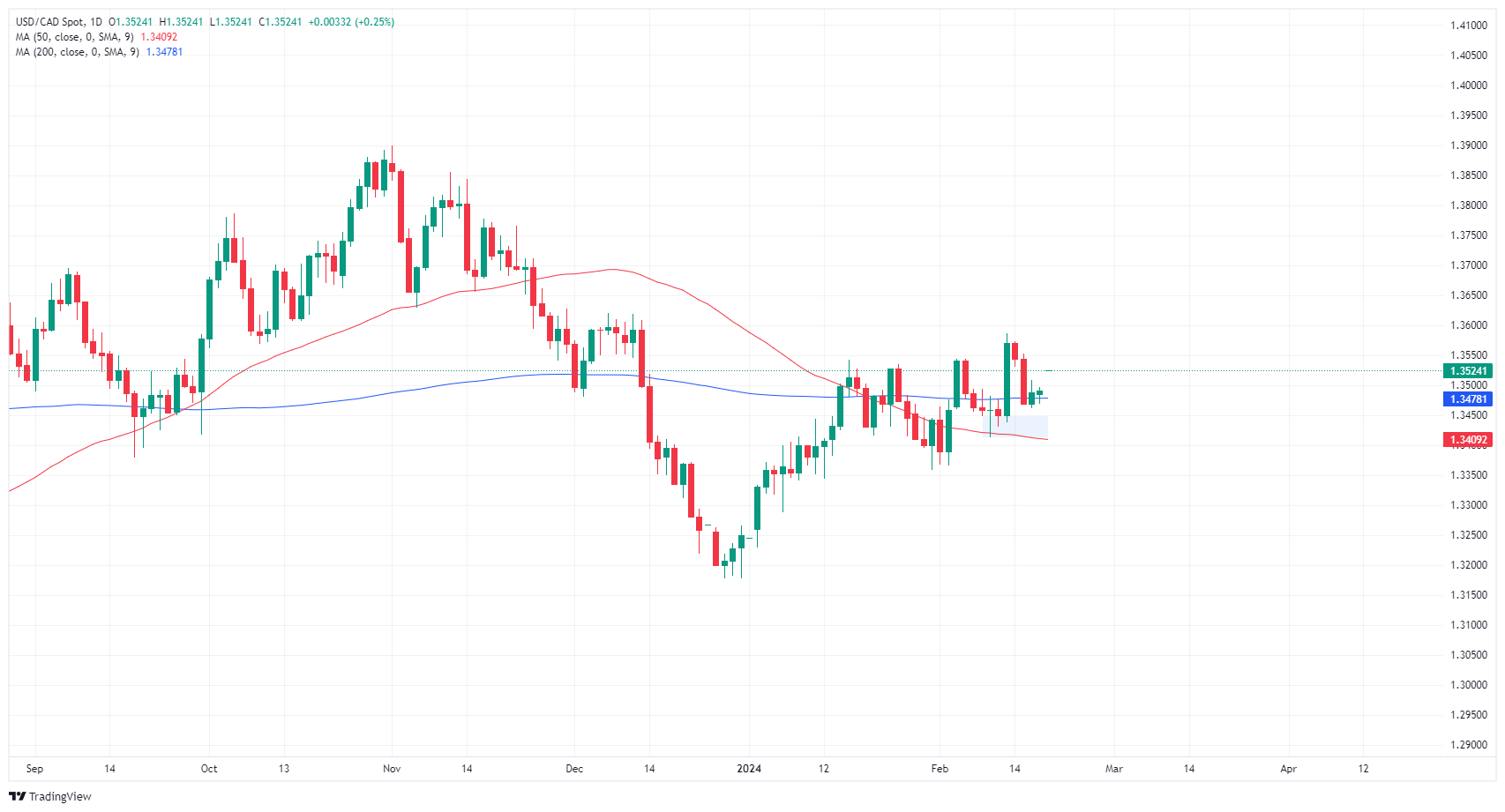- USD/CAD saw early declines before getting bolstered by a weak Canadian CPI.
- Canadian CPI inflation fell to 2.9% from the previous 3.4% YoY.
- Wednesday’s FOMC Meeting Minutes in the barrel as investors focus on rates.
USD/CAD fell to a daily low of 1.3472 on Tuesday before rebounding into an intraday high of 1.3530 after Canadian Consumer Price Index (CPI) inflation fell faster than markets expected. A weaker-than-expected Canadian inflation print softened the Canadian Dollar (CAD) across the board.
Canadian Retail Sales figures are due Thursday, and markets will be pivoting to focus on the Federal Reserve (Fed) and the Federal Open Market Committee (FOMC). The FOMC’s latest Meeting Minutes will drop on Wednesday.
Daily digest market movers: USD/CAD grapples with 1.3500 after Canadian inflation recedes
- Canadian CPI inflation declined to 2.9% for the year ended January, well below the forecast tick down to 3.3% from the previous period’s 3.4%.
- January’s MoM Canadian CPI printed unexpectedly at 0.0% versus the forecasted rebound to 0.4% from the previous month’s -0.3%.
- The Bank of Canada’s (BOC) Consumer Price Index Core for the year through January also declined to 2.4% from 2.6%.
- Canada CPI inflation falls to 2.9% vs. 3.3% expected
- Investors will be focusing on the FOMC’s latest Meeting Minutes on Wednesday as traders hope for signs the Fed will move closer to rate cuts.
- According to the CME’s FedWatch Tool, money markets are giving a 60% chance of no rate cut in May and 80% odds of at least a 25 basis point cut in June.
- Markets are expecting Thursday’s Canadian Retail Sales to bounce in December.
- MoM Retail Sales are expected to print at 0.8% versus the previous -0.2%, while Retail Sales Excluding Automobiles is forecast to recover to 0.7% from -0.5%.
Canadian Dollar price today
The table below shows the percentage change of Canadian Dollar (CAD) against listed major currencies today. Canadian Dollar was the weakest against the New Zealand Dollar.
| USD | EUR | GBP | CAD | AUD | JPY | NZD | CHF | |
| USD | -0.31% | -0.27% | 0.18% | -0.30% | -0.18% | -0.38% | -0.10% | |
| EUR | 0.31% | 0.04% | 0.49% | 0.01% | 0.13% | -0.07% | 0.21% | |
| GBP | 0.28% | -0.03% | 0.46% | -0.03% | 0.10% | -0.10% | 0.17% | |
| CAD | -0.18% | -0.49% | -0.44% | -0.47% | -0.36% | -0.55% | -0.28% | |
| AUD | 0.29% | -0.02% | 0.01% | 0.46% | 0.11% | -0.09% | 0.18% | |
| JPY | 0.18% | -0.12% | -0.10% | 0.34% | -0.13% | -0.20% | 0.07% | |
| NZD | 0.35% | 0.07% | 0.10% | 0.55% | 0.06% | 0.17% | 0.25% | |
| CHF | 0.11% | -0.21% | -0.17% | 0.28% | -0.20% | -0.08% | -0.28% |
The heat map shows percentage changes of major currencies against each other. The base currency is picked from the left column, while the quote currency is picked from the top row. For example, if you pick the Euro from the left column and move along the horizontal line to the Japanese Yen, the percentage change displayed in the box will represent EUR (base)/JPY (quote).
Technical analysis: USD/CAD bounces on post-CPI CAD weakness
Tuesday’s climb into 1.3530 filled the Fair Value Gap (FVG) from 1.3530 to 1.3470, and the pair hangs in the midrange surrounding the 1.3500 handle. The nearest supply zone rests just below 1.3450 and represents a significant buy zone, while top-side pressure sees heavy selling around the Order Block (OB) near 1.3580.
Daily candlesticks remain caught in a significant congestion zone as bids consolidate near the 200-day Simple Moving Average (SMA). The pair is caught between December’s lows near 1.3177 and last November’s peak just shy of 1.3900.
USD/CAD hourly chart
USD/CAD daily chart
Canadian Dollar FAQs
What key factors drive the Canadian Dollar?
The key factors driving the Canadian Dollar (CAD) are the level of interest rates set by the Bank of Canada (BoC), the price of Oil, Canada’s largest export, the health of its economy, inflation and the Trade Balance, which is the difference between the value of Canada’s exports versus its imports. Other factors include market sentiment – whether investors are taking on more risky assets (risk-on) or seeking safe-havens (risk-off) – with risk-on being CAD-positive. As its largest trading partner, the health of the US economy is also a key factor influencing the Canadian Dollar.
How do the decisions of the Bank of Canada impact the Canadian Dollar?
The Bank of Canada (BoC) has a significant influence on the Canadian Dollar by setting the level of interest rates that banks can lend to one another. This influences the level of interest rates for everyone. The main goal of the BoC is to maintain inflation at 1-3% by adjusting interest rates up or down. Relatively higher interest rates tend to be positive for the CAD. The Bank of Canada can also use quantitative easing and tightening to influence credit conditions, with the former CAD-negative and the latter CAD-positive.
How does the price of Oil impact the Canadian Dollar?
The price of Oil is a key factor impacting the value of the Canadian Dollar. Petroleum is Canada’s biggest export, so Oil price tends to have an immediate impact on the CAD value. Generally, if Oil price rises CAD also goes up, as aggregate demand for the currency increases. The opposite is the case if the price of Oil falls. Higher Oil prices also tend to result in a greater likelihood of a positive Trade Balance, which is also supportive of the CAD.
How does inflation data impact the value of the Canadian Dollar?
While inflation had always traditionally been thought of as a negative factor for a currency since it lowers the value of money, the opposite has actually been the case in modern times with the relaxation of cross-border capital controls. Higher inflation tends to lead central banks to put up interest rates which attracts more capital inflows from global investors seeking a lucrative place to keep their money. This increases demand for the local currency, which in Canada’s case is the Canadian Dollar.
How does economic data influence the value of the Canadian Dollar?
Macroeconomic data releases gauge the health of the economy and can have an impact on the Canadian Dollar. Indicators such as GDP, Manufacturing and Services PMIs, employment, and consumer sentiment surveys can all influence the direction of the CAD. A strong economy is good for the Canadian Dollar. Not only does it attract more foreign investment but it may encourage the Bank of Canada to put up interest rates, leading to a stronger currency. If economic data is weak, however, the CAD is likely to fall.
Information on these pages contains forward-looking statements that involve risks and uncertainties. Markets and instruments profiled on this page are for informational purposes only and should not in any way come across as a recommendation to buy or sell in these assets. You should do your own thorough research before making any investment decisions. FXStreet does not in any way guarantee that this information is free from mistakes, errors, or material misstatements. It also does not guarantee that this information is of a timely nature. Investing in Open Markets involves a great deal of risk, including the loss of all or a portion of your investment, as well as emotional distress. All risks, losses and costs associated with investing, including total loss of principal, are your responsibility. The views and opinions expressed in this article are those of the authors and do not necessarily reflect the official policy or position of FXStreet nor its advertisers. The author will not be held responsible for information that is found at the end of links posted on this page.
If not otherwise explicitly mentioned in the body of the article, at the time of writing, the author has no position in any stock mentioned in this article and no business relationship with any company mentioned. The author has not received compensation for writing this article, other than from FXStreet.
FXStreet and the author do not provide personalized recommendations. The author makes no representations as to the accuracy, completeness, or suitability of this information. FXStreet and the author will not be liable for any errors, omissions or any losses, injuries or damages arising from this information and its display or use. Errors and omissions excepted.
The author and FXStreet are not registered investment advisors and nothing in this article is intended to be investment advice.
Recommended content
Editors’ Picks

USD/JPY keeps range near 149.50 after BoJ's status quo
USD/JPY keeps its range near 149.50 in the Asian session on Wednesday. The Bank of Japan left the policy rate unchanged at 0.50% at its March meeting, offering little impetus to the Japanese Yen (JPY). The focus shifts to Governor Ueda's press conference for fresh cues on future rate hikes.

AUD/USD remains stuck in a range near 0.6350 as Fed decision looms
AUD/USD consolidates in a tight band near 0.6350 early Wednesday as traders turn to the sidelines ahead of the Fed policy decision. The US Dollar languishes near a five-month low amid dovish Fed bets, cushioning the Aussie's downside Meanwhile, geopolitical tensions remain a drag on the pair.

Gold buyers take a breather ahead of the Fed verdict
Gold price is consolidating the recent upsurge to a record high of $3,038 in Wednesday’s Asian trading hours. Gold buyers take a breather as a sense of caution prevails, heading toward the all-important US Federal Reserve monetary policy announcements due later in the day.

Bitcoin, Ethereum and Ripple expect volatility around the FOMC meeting
Bitcoin and Ripple prices face resistance around their key levels; a firm close above indicates recovery on the cards, while Ethereum price finds support at its critical level, suggesting a bounce ahead.

Tariff wars are stories that usually end badly
In a 1933 article on national self-sufficiency1, British economist John Maynard Keynes advised “those who seek to disembarrass a country from its entanglements” to be “very slow and wary” and illustrated his point with the following image: “It should not be a matter of tearing up roots but of slowly training a plant to grow in a different direction”.

The Best brokers to trade EUR/USD
SPONSORED Discover the top brokers for trading EUR/USD in 2025. Our list features brokers with competitive spreads, fast execution, and powerful platforms. Whether you're a beginner or an expert, find the right partner to navigate the dynamic Forex market.